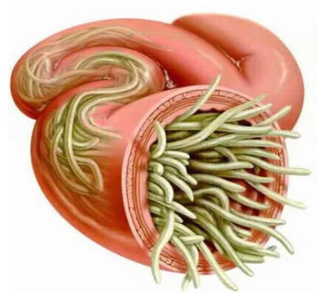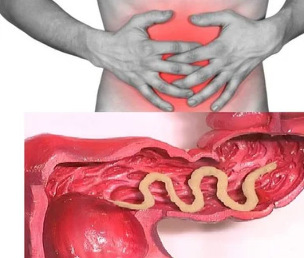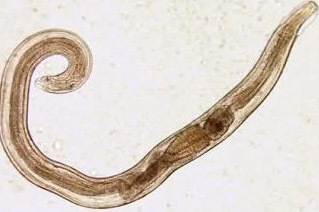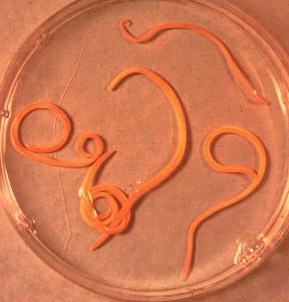Today, there are about 280 species of worms, which can grow and live in the human body, diseases of various organs and tissues. The frequency of infection in the worms to man depending on the climate and socio-economic conditions in certain areas (in less developed countries, especially those located in the tropical subtropical region and, the level of parasitic infections is much higher than in economically developed countries).
Ways of human infection with helminths:
- Bioelements (infection of animals).
- Helminth infections contagious (transmitted from person to person).
- Geohelminths (the disease caused by the parasite corresponds to one life cycle to the ground).

Factors that affect the symptoms of helminthiasis
The method of penetration of the parasite into the body:
- The degree of adaptation of worms in the human body;
- Population density (number) of parasitic specimens;
- The habitat of the worm (tissue parasites live in the thick tissue soft and live luminal Lumina of hollow organs). Some helminths is both different stages of the luminal tissue, and forms. And developing larval stages of worms, as a rule, cause more serious pathological changes.
Without re-infection, adult parasites in the human body number is not increased. This feature distinguishes helminth infection diseases caused by bacteria, viruses, fungi and protozoa organisms.
Worms in humans: symptoms
Helminthiasis is a disease that is characterized by 2-phase flow (sharp, from two weeks to two months) and chronic (several months to several years).
Symptoms of the acute phase of helminth infections
The first mark of the disease can occur at different times (often 2-3 weeks, ascariasis – 2-3 days after, and when filariose incubation period can last from 6-18 months).
In the acute phase of parasitic infestation the most common symptom is an allergic reaction (it is developed against agents, the antigens of the migrating larvae of parasites). Often, people infected with worms appear on the skin itchy rash, prone to a relapsing course, adding to the local lymph nodes, can cause or generalized local swelling, muscle and joint pain. The migrating larvae of the parasite can cause pains in the chest, cough, asthma, disorders of stool, and nausea vomiting.
At the same time, acute helminth infections phase may be involved in more severe diseases (severe form of pneumonia, hepatitis, allergic myocarditis, hepatosplenomegaly (enlarged liver and spleen).
In the blood, increases the number of eosinophils (eosinophilia) and interferes with the normal quantitative ratio of protein fractions (dysproteinemia).

Signs of chronic helminthiasis
The symptoms of chronic stage depends on which body is "inhabited" by the parasites, and play an important role as also their size and number.
So when the parasite in the intestine of individuals, the disease can be asymptomatic (with the exception of cases where a very large parasites). Characteristics of the chronic phase of intestinal helminths have dyspepsia. Children are largely expressed asthenoneurotic and pain. Massive infestation by Ascaris may develop intestinal obstruction, obstructive jaundice and pancreatitis.
Consume all necessary action of substances of the host organism, the worms cause digestive disorders, malabsorption of vitamins, minerals, carbohydrates, proteins and fats. At the same time, the slag worms block the normal intestinal flora lowers the immune system's power and the body.
People who suffer from helminthiasis, because of a weakened immune system, and enhanced the cell division process (in the study of permanently damaged tissue parasites) significantly increases the risk of malignant tumors.
Species of helminths, parasites of the human body
The causative agents of human helminthiasis 2 types of worms: round (nematodes) and flat (tapeworms and flukes).
Shuttle
Pinworm
Parasites, which are small cause pinworms (up to 10 mm), thin stomach worms, which have a grayish-white color. Infection occurs through the digestive tract (orally). The reason is dirty hands. The eggs of the parasite can stay in the country, the fleece-infected animals, unwashed fruits and vegetables, etc. however, when enterobiasis cases, samsara jade (especially children), who due to scratching the itchy areas and if the the ingestion of eggs. Pinworm larvae develop within two weeks of the gastrointestinal tract. Becoming an adult worm of the parasite, the lower thin and upper part of the colon.

Ascaris
Ascaris is a parasite of large fusiform red-home / company, an adult of 40 cm (women) and 15 to 25 cm (males). There is no other suction cup or mounting devices, Ascaris is able to move food towards the masses. Eggs female of the parasite excreted in the feces.
Infected ascariasis paid in that case, the ingestion of Mature eggs and water, or unwashed fruits and vegetables, which contain soil particles. After penetration of the egg in the intestine the larvae are matured. Then, penetrates the intestinal wall, he, through the bloodstream reaches the heart and from there to the lungs. Through the lung alveoli roundworm larvae through the respiratory tract enters again into the oral cavity. After re-ingestion of the parasites reach the small intestine, where he will develop into an adult. Worm live 12 months, dies and then is excreted along with feces. The intestine of the host, one can live as one and several hundreds of individuals.
Whipworm
Whipworm, which causes trichuriasis is white worms, parasitic in the colon of the first part and reach the size of 4-5 cm of the parasite and the blood of the son Feeds the tissue of the mucous membranes of the rectum.
Whipworm eggs, the female intestine, come out with feces. Their development paid for the environment (optimally the soil). Eggs are matured they are the larvae of the parasite enter the body through the digestive systems of the body through dirty hands, water or unwashed vegetables and fruits.

The Species Trichinella
The causative agent of trichinosis is a small round worms, reaching 2-5 mm long. Infection paid by eating undercooked meat (pork, bear meat, wild boar or). Penetrates the intestine, the larvae of the parasite within 3-4 days Maturation state of the Mature individuals. The lifetime of the worm 40 days, after which the parasite dies. Proberably the intestinal wall, the larvae penetrate the bloodstream and spread to all the organs of the human body, settle on the muscles. In this case, most often affects the respiratory and facial muscles, and the muscles of the limbs.
Released in the first days after the attack, patients complain of abdominal pain. Then, after about 2 weeks, the body temperature rises to 39-40 ° C, appear on the skin itchy rash to develop muscle pain, swollen face. During this time, if a massive infection is a significant death table. After about a month of recovery from a paid. The parasite is encapsulated in a spiral shape, which after two years will die.
And Ancylostoma necator
Those two pigs biological properties are similar and called diseases. In this regard, he decided to combine the name of the connection (hookworm). Worms, reaching a length of 10-15 mm, feed 12-p. the intestine. The key role of the environment, that this is one of the most common, but at the same time rarely noticeable parasites. The larvae penetrate the people and the worms in the body of the skin through contact with infected soil. Still, once in the bloodstream, they, as well as roundworm migrate to the lungs and one in the bronchi otharkivajushche the gastrointestinal tract of mucus. Ancylostoma parasites in the intestine, by connecting it to the intestinal wall. Parasites that feed exclusively on blood, puree penetrates into the mucus membrane of the blood vessels and injecting anti-coagulant, some not. During the day, adults on average can absorb 0,05-0, 35 ml of blood. Therefore, a typical symptom of this helminthiasis is iron deficiency anemia, variable and ratio of protein fractions (dysproteinemia).
Flat worms
Tapeworm
This is one of the largest worms, reaching a length of 10-20 meters. A disease caused by a parasite, which is called difillobotrioz. The developmental cycle of the worm begins to fresh water or this a popular place for crabs. The human body, which is the last host of the broad tapeworm, the larvae and association agreement with the caviar one or the infected fish fillet. Reach the small intestine, the parasite attaches to the wall within 20 to 25 days and growth of Mature individuals.
Liver Fluke
The parasite that causes opisthorchiasis is a flat worm, reaching a length of 7-20 mm. the key role of the environment, that more than 50% of cases infected with liver fluke (also called cat Fluke) affect the citizens of Loviisa to the Russian. The parasite larvae begin to develop, common when the eggs in fresh water (to swallow them snails). Further they penetrate into the body of this popular place (carp, crucian carp, bream, roach). Infected people paid by eating contaminated this popular place of meat, which is not sufficient to pass the gulf of the heat treatment. The larvae of the liver Fluke from the small intestine penetrate into the biliary ducts and gall bladder, e, it allows the two suction cups.
Beef and pork tapeworm
These are almost identical in structure, the parasite reaches a length of 5-6 meters. Infection beef tapeworm infection and teniasis due to eating beef or pork infected with the Finns (one of the intermediate forms of helminthiasis). The viability of the Finns presented in the form of whitish bubbles reaches a size of 0.5 cm attached to the wall of the small intestine of man and adult to 3 months is changing. Belt of the parasite, which is comprised of over 2000 segments, is constantly growing. However, the content, its major segments, which contain eggs, break through and move independently of the colon to the anus, and then crawl out of the anus, or the environment in the faeces. The most common symptoms of helminth infections is disruption of the digestive tract.
Echinococcus
This parasite, man is the intermediate host. The worm is parasitic in the human body in the form of Finnish. The definitive host of the Echinococcus – a wolf, a dog or a cat. Infection occurs through the digestive systems of the body common animals, objects and environmental contamination with eggs of Echinococcus. Entering the intestine after which develop oncospheres (larvae shestigrannye). From the intestine they penetrate the bloodstream and spread throughout the body.
Alveolar
This parasite, which is considered a species of Echinococcus is one of the reasons of the most dangerous helminth infections (and alveococcosis), where gravity flow is similar to the ny-cirrhosis of the liver liver cancer. Infection paid the penetration of oncospheres (eggs Mature larvae) in the intestine. There the embryo is born of the egg, ny, penetrates the intestinal wall through the enters the bloodstream. Further, the bloodstream is divided into parasites and all the tissues of the organs (most often localized in the liver). On top of That, if larvae are found in the main phase (formed in the multi-bubble, labrocyte). Each review contains the embryo's head is a parasite, which develops gradually. Eurocity is a very aggressive formation, is constantly growing, because more bubbles, it is also the ability to grow in the liver, such as cancer metastasis.
Diagnostics of helminthiasis
Diagnosis of worm infestation include the following activities:
- a thorough history, to help identify possible causes of infection;
- laboratory studies of stool, blood, content, 12P colon, rectum and anus mucus, muscle tissue, lung mucus, bile. Analysis can identify the eggs, segments or fragments of parasites. However, elevated blood son of eosinophils is also a signal English helminthiasis.
- diagnosis of diseases caused by the larval stage or tissue parasites are serology (IFA, RSK, the reaction of indirect agglutination, immunofluorescence analysis etc.).
- for detecting the helminths, which affect the liver tissue, is determined by ultrasound, CT and endoscopic examinations.
Worms in humans treatment
In the acute phase of parasitic infection, the patient is prescribed detoxication desensitizing treatment and. In severe course of the disease (a trematode of the liver, trichinosis) medical indications to use glucocorticoids.
Like drugs specific treatment of the nature of a special agent of the de-worming chemotherapeutic agents.
At the same time, it is recommended the patient take and antihistamines chelators. The final stage of the treatment involves using probiotics to normalize the intestinal microflora.
Also appointed to the special sparing diet (food easily and should digest contained in the in vain a little fat).
In antihelminthic treatment the patient requires strict adherence to personal hygiene (to prevent reinfestation). At the same time, many of the helminth infections, the treatment must go through all members of the family and the person infected with constant contact.






































